In 2021, the presidential administration passed the National Security Memorandum on Improving Cybersecurity for Critical Infrastructure Control Systems, aiming to bolster the cybersecurity posture of critical infrastructure in the United States. Various agencies, such as the Transportation Security Administration (TSA), Department of Transportation (DOT) and the Cybersecurity Infrastructure Security Agency (CISA), have been working to continuously improve the security of the transportation sector, which oversees the movement of people and goods across the country.
The Transportation Sector
Within the transportation sector, initiatives have been taken to help fund cybersecurity improvements in an array of subsectors. The transportation sector includes:
- Aviation: Approximately 450 commercial airports, 19,000 airfields, air traffic control systems, heliports, landing strips, joint-use military airports, sea plane bases, manned and unmanned recreational aircraft and flight schools[1]
- Highway and motor carriers: Managing roadways, bridges, tunnels and commercial vehicles such as motorcoaches and school buses traffic management systems
- The maritime transportation system: Approximately 95,000 miles of coastline, 361 ports and over 10,000 miles of navigable waterways
- Mass transit and passenger rail: Terminals, operational systems, transit buses, monorails, trolleys and rideshares
- Pipeline systems: Carriers of natural gas, hazardous liquids and various chemicals
- Freight rail: Major carriers, smaller, active railroads, freight cars and locomotives
- Postal and shipping: Regional and local couriers, mail management firms, charters and delivery services[2]
 Security Directives
Security Directives
Due to persistent threats to the cybersecurity of critical infrastructure, including the transportation sector, the TSA issued multiple security directives for various transportation types, including railways and pipelines. These new directives require agencies to develop approved implementation plans that will help improve cybersecurity resilience, proactively assess the effectiveness of cybersecurity measures and prevent the deterioration of infrastructure.
The directive also requires that entities regulated by the TSA proactively work to implement amendments in the directive, including to:
- Develop network segmentation policies so that Operational Technology (OT) can continue working, even when compromised
- Prevent unauthorized access to critical infrastructure systems by enabling control access measures
- Identify vulnerabilities and implement security patches for operating systems, applications, drivers and firmware to reduce the risk of exploitation
- Detect malicious software and unauthorized access on Information Technology (IT) or OT systems and report designated incidents to CISA
- Isolate infected systems from uninfected systems to limit the spread of malware, deny further access and to preserve evidence of compromise[3]
A similar initiative, introduced by the DOT in 2022, aims to improve security awareness amongst employees. All DOT network users are required to complete the DOT’s Security Awareness Training, which is inspired by various federal requirements and the DOT Order on Department Cybersecurity Policy. The training measures employees’ knowledge in cybersecurity, including password and PIN protection and basic security for information systems.[4]
By striving to improve the security posture of the transportation sector, the TSA, DOT and CISA endeavor to protect the safety of the nation.
Cybersecurity Funding for the Future
The DOT has also introduced measures to improve the national security posture. To leverage funding from bipartisan infrastructure, the U.S. Transportation Secretary Pete Buttigieg announced up to $45 million in grants for various University Transportation Centers (UTC). These grants will be utilized to improve the cybersecurity resilience of agencies affiliated with roads, bridges, rail, shipping and airspace. One of these grants will go to Clemson University to lead a consortium focused on cybersecurity research and development. Another of these grants will go to Prairie View A&M University to improve technology in the transportation system, including data related to artificial intelligence and environmental resilience.[5]
Ever since the Colonial Pipeline attack of 2021, as well as other attacks on the cybersecurity of critical infrastructure of the United States, various agencies have done their part to improve the nation’s security. Through CISA’s hard work to create cybersecurity guidelines and cross-sector performance goals and the Federal Government’s generous grants, the nation’s critical infrastructure is postured to increase security and resolve potential crises.
This blog is the final installment in our four-part series, which examines cybersecurity initiatives inspired by The White House’s National Security Memorandum. The first three parts covered the basics of critical infrastructure cybersecurity, an overview of the Water and Wastewater Sector, and an overview of the Electric and Utility Sector.
To learn more about how agencies can bolster their cybersecurity efforts within critical infrastructure, visit Carahsoft’s Cybersecurity Solutions Portfolio.
Resources:
[1] “National Infrastructure Protection Plan,” Transportation Systems Sector, https://www.dhs.gov/xlibrary/assets/nipp_transport.pdf
[2] “Transportation Systems Sector,” Cybersecurity and Infrastructure Security Agency, https://www.cisa.gov/topics/critical-infrastructure-security-and-resilience/critical-infrastructure-sectors/transportation-systems-sector
[3] “Security Directives and Emergency Amendments,” Transportation Security Administration, https://www.tsa.gov/sd-and-ea
[4] “FY 2022 Department of Transportation Security Awareness Training,” Federal Motor Carrier Safety Administration, https://www.fmcsa.dot.gov/safety/fy-2022-department-transportation-security-awareness-training
[5] “U.S. Department of Transportation Funds Innovative Research Providing Vital Training for Next Generation of Transportation Leaders,” U.S. Department of Transportation, https://www.transportation.gov/briefing-room/us-department-transportation-funds-innovative-research-providing-vital-training-next

 Untapped Resources
Untapped Resources